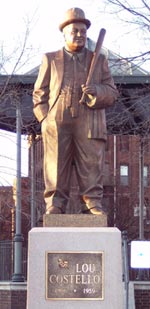

I’ve been wondering lately whether Williams’
Paterson might help me think through issues on another topic I’ve been writing on—
Pierre Schaeffer’s acousmatic music and contemporary uses of the term acousmatic. Both Williams’ and Schaeffer’s work draw from
the fragment, snapped out of the flow of life, and transformed in the work. The notion of the acousmatic implies that, with recorded sound you listen blindly—the lawn mower weaned of its backyard and whirled into multitimbral projections (something that the word cannot do as easily, unless all semantic and word-based elements are erased –cf. the
poesie sonore of
Henri Chopin, et al). Yet, with tape music, before these sounds become otherworldly, they are in the world, and the choice one makes to sample or process a sound is not an arbitrary or unmeaningful one (I once had a student who told me his abstract sound piece was composed of the recordings of holocaust survivors he found on the web; he didn’t seem to have any investment in either why he chose the samples or distorted them beyond recognition, other than that they were there and he could do it.) Contemporary, conservative acousmatic artists will claim that the referent does not matter in the pursuit of some purist idea of art.
Francisco Lopez, perhaps the most anxious of these latter-day acousmatisticians, seems so put upon by the idea of significance that he goes as far as to say: “There can only be a documentary or communicative reason to keep the cause-object relationship in the work with soundscapes,
never an artistic/musical one.” But it’s precisely the communicative and documentary urges that motivate both Williams and Schaeffer to create texts uniquely drawn from the world—not to reflect it, but to imagine new relations. In his essay “Hypermetrics” Sean Cubitt says, “Williams is prepared to open the foot to relativity, not only in the abstract, but in the weight of the relations between people that are concretised in words” (
Writing Aloud 122). Compare Schaeffer, who old-school acousmatician
Francois Bayle describes as wanting to “relate a musical object to its most general context,
to the spiritual destiny of the period” by arraying “marks, blank spaces, questioning forms which, . . . designate what
neither shows nor conceals, but beckons.” There is a sense that, far from lugging the reel to reels up high Parnassus, the acousmatic musician threaded his capstans to navigate the high seas of "unmusical" sound, as well as the oceanic substance of future time itself. As such, he needed to create a network of relays between the documentary source of the recordings, the present tense of composition, and the future relations such experimentations heralded. Perhaps what haunts both Schaeffer’s and Williams’ experiments is the intractability of the real, but what makes them still valid is their hypostatizing of democratic ideals in form and their openness to the potential of the future. Sean Cubitt goes on to say, “Capital’s social relations could not afford a resolution: the power of this poetry arises from its failure.” (123) Strange sentence, that. Does “its” refer to the social relations or to poetry? I guess, maybe to inaccurately quote a line I heard Charles Bernstein once deliver, red wheelbarrowing-it for the audience, “so much depends upon what you mean by failure.”
Labels: acousmatics, Charles Bernstein, democracy, fragments, Francisco Lopez, Francois Bayle, Henri Chopin, musique concrete, Pierre Schaeffer, Sean Cubitt, the real





